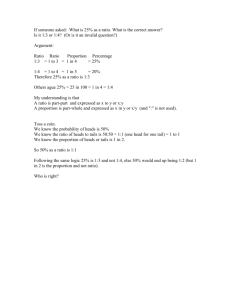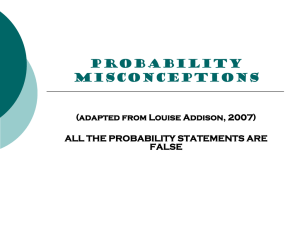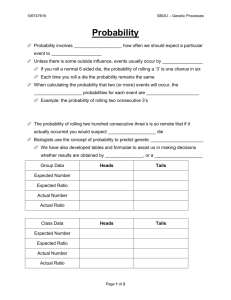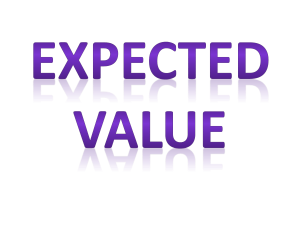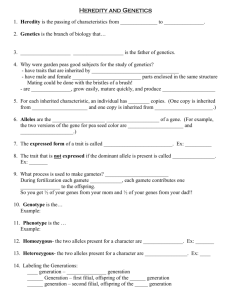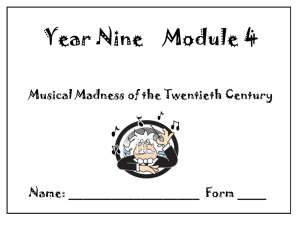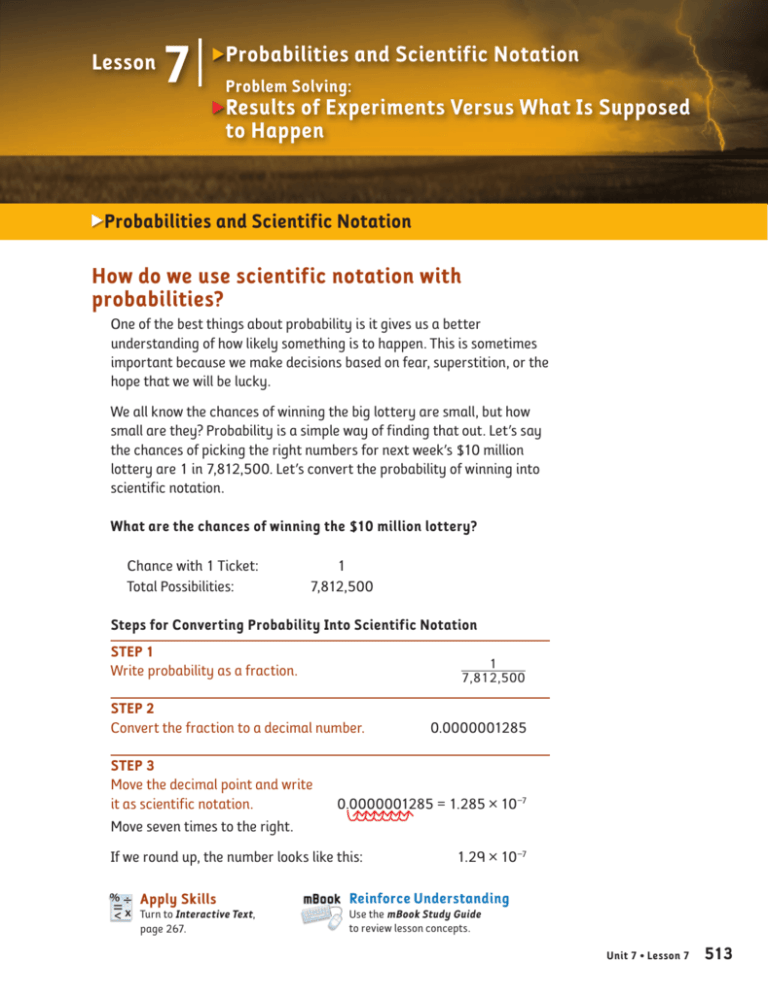
Lesson
7 Probabilities and Scientific Notation
Problem Solving:
Results of Experiments Versus What Is Supposed
to Happen
Probabilities and Scientific Notation
How do we use scientific notation with
probabilities?
One of the best things about probability is it gives us a better
understanding of how likely something is to happen. This is sometimes
important because we make decisions based on fear, superstition, or the
hope that we will be lucky.
We all know the chances of winning the big lottery are small, but how
small are they? Probability is a simple way of finding that out. Let’s say
the chances of picking the right numbers for next week’s $10 million
lottery are 1 in 7,812,500. Let’s convert the probability of winning into
scientific notation.
What are the chances of winning the $10 million lottery?
Chance with 1 Ticket:
Total Possibilities:
1
7,812,500
Steps for Converting Probability Into Scientific Notation
Step 1
Write probability as a fraction.
1
7,812,500
Step 2
Convert the fraction to a decimal number.
Step 3
Move the decimal point and write
it as scientific notation.
Move seven times to the right.
0.0000001285 = 1.285 × 10−7
If we round up, the number looks like this: Apply Skills
Turn to Interactive Text,
page 267.
0.0000001285
1.29 × 10−7
Reinforce Understanding
Use the mBook Study Guide
to review lesson concepts.
Unit 7 • Lesson 7 513
Lesson 7
Problem Solving: Results of Experiments Versus What Is Supposed to Happen
What is the difference between what actually
happens and what was supposed to happen?
We have flipped coins and rolled dice in this unit as a way of
understanding probabilities. Sometimes what has happened doesn’t
match what is supposed to happen. The differences between
what occurs in an experiment and what our math calculations tell
us should happen have names. We use two phrases to describe
these differences.
• Experimental probabilities are the results of experiments.
These are based on what actually happens.
• Theoretical probabilities are the results of our calculations. They
tell us what should happen in theory based on “doing the math.”
To help us see what is supposed to happen (the theoretical probabilities),
we can make tables or draw tree diagrams.
Let’s use an example of flipping coins. What are the chances of flipping
2 heads in a row?
Example 1
Use a table to show all of the possible outcomes of two flips.
This table shows all of the possible outcomes of two flips. This is the
sample space for all of the coin tosses. The first row of the table shows
the chances of 2 heads in a row. The next three rows show the other
possible outcomes of flipping a coin two times.
Flip 1
Heads
Heads
Tails
Tails
Flip 2
Heads
Tails
Heads
Tails
Outcome
Heads and Heads
Heads and Tails
Tails and Heads
Tails and Tails
What are the chances of flipping 2 heads in a row?
Outcomes with 2 heads in a row: 1
Total possibilities: 4
1
4 = 0.25 or 25%
The probability is 0.25 or 25 percent.
514 Unit 7 • Lesson 7
Vocabulary
experimental
probability
theoretical
probability
Lesson 7
Example 2 shows how to use a tree diagram to find two different
probabilities. The first probability is the chance of flipping a heads first
and then a tails. The second probability is just the chance of getting a
heads and a tails in any order.
Example 2
Use a tree diagram to find probabilities.
Flip 1
Flip 2
Heads
Outcome
Heads and Heads
Heads
Tails
Heads and Tails
Heads
Tails and Heads
Start
Tails
Tails
Tails and Tails
What are the chances of flipping a heads first and then a tails?
Chance of heads and then tails: 1
Total possibilities: 4
The probability is 14 = 0.25, or 25%
What are the chances of flipping a heads and a tails in any order?
Chance of heads and tails in any order: 2
Total possibilities: 4
The probability is 2
4 = 0.50, or 50%
The tree shows us all of the possible outcomes. There are four possible
outcomes, and there are two chances of getting a heads and tails in
any order.
Problem-Solving Activity
Turn to Interactive Text,
page 268.
Reinforce Understanding
Use the mBook Study Guide
to review lesson concepts.
Unit 7 • Lesson 7 515
Lesson 7
Homework
Activity 1
Rewrite each of the numbers using scientific notation.
1. 2,300 2. 0.005 3. 42,000 4. 0.76 5. 785,000 6. 0.0000000025 7. 0.00345 8. 1,810,000 Activity 2
Rewrite the probabilities using scientific notation.
1. The chance of becoming a pro athlete is 22,000 to 1 or 0.000045. Write this
number using scientific notation.
2. The chance of bowling a 300 game is 11,500 to 1 or 0.000087. Write this
number using scientific notation.
3. The chance of getting a hole in one is 5,000 to 1 or 0.0002. Write this
number using scientific notation.
4. The chance of catching a ball at a major league ballgame is 563 to 1 or
0.0018. Write this number using scientific notation.
5. The chance of winning an Olympic medal is 662,000 to 1 or 0.0000015.
516 Unit 7 • Lesson 7
Copyright 2010 by Cambium Learning Sopris West®. All rights reserved. Permission is granted to reproduce this page for student use.
Lesson 7
Homework
Activity 3
Look at the possible outcomes of the experiment in this tree diagram. Then
answer the questions.
1st Draw
2nd Draw
Outcome
Red
Red/Red
White
Red/White
Red
White/Red
White
White/White
Red
Start
White
1. What’s the chance of drawing two reds in a row?
2. What’s the chance of drawing a white and then a red?
3. What’s the chance of drawing one color and then the other?
4. What’s the chance of drawing two of the same color?
Activity 4 • Distributed Practice
Solve.
1.
4
5
2
÷ 10
2. 13.8 · 1.1 3. 189.78 + 235.46 5.
11
16
− 58 1
16
7. What fraction is 2%? 4.
4
5
· 29 8
45
6. What percent is 0.25? 1
50
7
8. Convert 10 to a decimal number.
Copyright 2010 by Cambium Learning Sopris West®. All rights reserved. Permission is granted to reproduce this page for student use.
Unit 7 • Lesson 7 517

